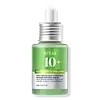What's inside
What's inside
 Key Ingredients
Key Ingredients

 Benefits
Benefits

 Concerns
Concerns

 Ingredients Side-by-side
Ingredients Side-by-side

Water
Skin ConditioningAzelaic Acid
BufferingPropylene Glycol
HumectantSodium Hydroxide
BufferingDipropylene Glycol
Humectant1,2-Hexanediol
Skin ConditioningPanthenol
Skin ConditioningHydroxyethylcellulose
Emulsion StabilisingBetaine Salicylate
AntimicrobialGlycerin
HumectantBiosaccharide Gum-1
HumectantEthylhexylglycerin
Skin ConditioningAllantoin
Skin ConditioningDipotassium Glycyrrhizate
HumectantMelia Azadirachta Leaf Extract
Skin ConditioningCamellia Sinensis Leaf Water
MaskingSodium Hyaluronate
HumectantMelia Azadirachta Flower Extract
Skin ConditioningNiacinamide
SmoothingAloe Barbadensis Leaf Juice
Skin ConditioningBeta-Glucan
Skin ConditioningCentella Asiatica Extract
CleansingCentella Asiatica Leaf Extract
Skin ConditioningCentella Asiatica Root Extract
Skin ConditioningMadecassoside
AntioxidantAsiaticoside
AntioxidantAsiatic Acid
Skin ConditioningMadecassic Acid
Skin ConditioningSqualane
EmollientZinc PCA
HumectantButylene Glycol
HumectantPentylene Glycol
Skin ConditioningCaprylyl/Capryl Glucoside
CleansingHydrogenated Lecithin
EmulsifyingCeramide NP
Skin ConditioningWater, Azelaic Acid, Propylene Glycol, Sodium Hydroxide, Dipropylene Glycol, 1,2-Hexanediol, Panthenol, Hydroxyethylcellulose, Betaine Salicylate, Glycerin, Biosaccharide Gum-1, Ethylhexylglycerin, Allantoin, Dipotassium Glycyrrhizate, Melia Azadirachta Leaf Extract, Camellia Sinensis Leaf Water, Sodium Hyaluronate, Melia Azadirachta Flower Extract, Niacinamide, Aloe Barbadensis Leaf Juice, Beta-Glucan, Centella Asiatica Extract, Centella Asiatica Leaf Extract, Centella Asiatica Root Extract, Madecassoside, Asiaticoside, Asiatic Acid, Madecassic Acid, Squalane, Zinc PCA, Butylene Glycol, Pentylene Glycol, Caprylyl/Capryl Glucoside, Hydrogenated Lecithin, Ceramide NP
Water
Skin ConditioningDicaprylyl Carbonate
EmollientPotassium Azeloyl Diglycinate
Skin ConditioningMaltodextrin
Absorbent1,2-Hexanediol
Skin ConditioningPropanediol
SolventAvena Sativa Kernel Extract
AbrasiveAloe Barbadensis Leaf Juice
Skin ConditioningDipotassium Glycyrrhizate
HumectantSodium Hyaluronate
HumectantPanthenol
Skin ConditioningHydroxyacetophenone
AntioxidantLactic Acid
BufferingBenzoic Acid
MaskingCitric Acid
BufferingSodium Lactate
BufferingSodium Gluconate
Skin ConditioningSclerotium Gum
Emulsion StabilisingPolyglyceryl-2 Stearate
EmulsifyingXanthan Gum
EmulsifyingGlyceryl Stearate
EmollientStearyl Alcohol
EmollientWater, Dicaprylyl Carbonate, Potassium Azeloyl Diglycinate, Maltodextrin, 1,2-Hexanediol, Propanediol, Avena Sativa Kernel Extract, Aloe Barbadensis Leaf Juice, Dipotassium Glycyrrhizate, Sodium Hyaluronate, Panthenol, Hydroxyacetophenone, Lactic Acid, Benzoic Acid, Citric Acid, Sodium Lactate, Sodium Gluconate, Sclerotium Gum, Polyglyceryl-2 Stearate, Xanthan Gum, Glyceryl Stearate, Stearyl Alcohol
 Reviews
Reviews

Ingredients Explained
These ingredients are found in both products.
Ingredients higher up in an ingredient list are typically present in a larger amount.
1,2-Hexanediol is a synthetic liquid and another multi-functional powerhouse.
It is a:
- Humectant, drawing moisture into the skin
- Emollient, helping to soften skin
- Solvent, dispersing and stabilizing formulas
- Preservative booster, enhancing the antimicrobial activity of other preservatives
Aloe Barbadensis Leaf Juice comes from leaves of the aloe plant. Aloe Barbadensis Leaf Juice is best known for helping to soothe sunburns. It is also anti-inflammatory, moisturizing, antiseptic, and can help heal wounds.
Aloe is packed with good stuff including Vitamins A, C, and E. These vitamins are antioxidants, which help fight free-radicals and the damage they may cause. Free-radicals are molecules that may damage your skin cells, such as pollution.
Aloe Barbadensis Leaf Juice also contains sugars. These sugars come in the form of monosaccharides and polysaccharides, folic acid, and choline. These sugars are able to help bind moisture to skin.
It also contains minerals such as calcium, 12 anthraquinones, fatty acids, amino acids, and Vitamin B12.
Learn more about Aloe Barbadensis Leaf JuiceDipotassium Glycyrrhizate comes from licorice root.
Extracts of licorice have demonstrated to have antibacterial, anti‐inflammatory, antiviral, antioxidant properties.
One component, glabridin, has extra potent antioxidant and soothing properties. It has also been found to block pigmentation from UVB rays in guinea pigs.
Licorice Root also contains a flavonoid. Flavonoids are a natural substance from in plants. Flavonoids also have antioxidant properties.
Another component, glycyrrhizin, has been found to have anti-inflammatory and antimicrobial benefits. This may make licorice root extract effective at treating acne. However, more research is needed to support this.
Liquiritin is one of the flavone compounds found in licorice. It has been found to help lighten skin by preventing tyrosinase from reacting with tyrosine. When the two react, protein is converted to melanin. Melanin is the substance in your body that gives your features pigmentation.
Licorice root is native to Southern Europe and Asia. It has been used in traditional Chinese medicine to help with respiratory issues.
Learn more about Dipotassium GlycyrrhizatePanthenol is a common ingredient that helps hydrate and soothe the skin. It is found naturally in our skin and hair.
There are two forms of panthenol: D and L.
D-panthenol is also known as dexpanthenol. Most cosmetics use dexpanthenol or a mixture of D and L-panthenol.
Panthenol is famous due to its ability to go deeper into the skin's layers. Using this ingredient has numerous pros (and no cons):
Like hyaluronic acid, panthenol is a humectant. Humectants are able to bind and hold large amounts of water to keep skin hydrated.
This ingredient works well for wound healing. It works by increasing tissue in the wound and helps close open wounds.
Once oxidized, panthenol converts to pantothenic acid. Panthothenic acid is found in all living cells.
This ingredient is also referred to as pro-vitamin B5.
Learn more about PanthenolSodium Hyaluronate is hyaluronic acid's salt form. It is commonly derived from the sodium salt of hyaluronic acid.
Like hyaluronic acid, it is great at holding water and acts as a humectant. This makes it a great skin hydrating ingredient.
Sodium Hyaluronate is naturally occurring in our bodies and is mostly found in eye fluid and joints.
These are some other common types of Hyaluronic Acid:
Learn more about Sodium HyaluronateWater. It's the most common cosmetic ingredient of all. You'll usually see it at the top of ingredient lists, meaning that it makes up the largest part of the product.
So why is it so popular? Water most often acts as a solvent - this means that it helps dissolve other ingredients into the formulation.
You'll also recognize water as that liquid we all need to stay alive. If you see this, drink a glass of water. Stay hydrated!
Learn more about Water